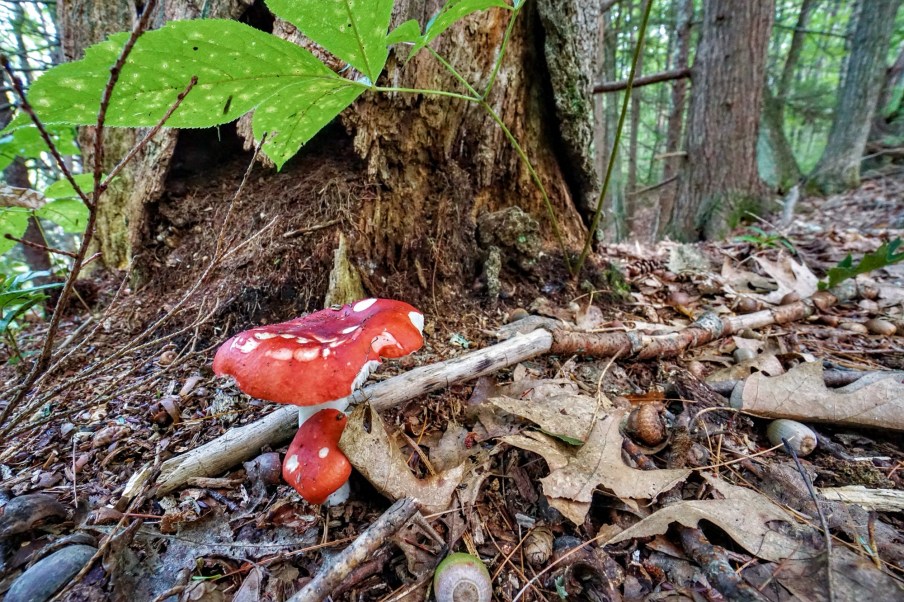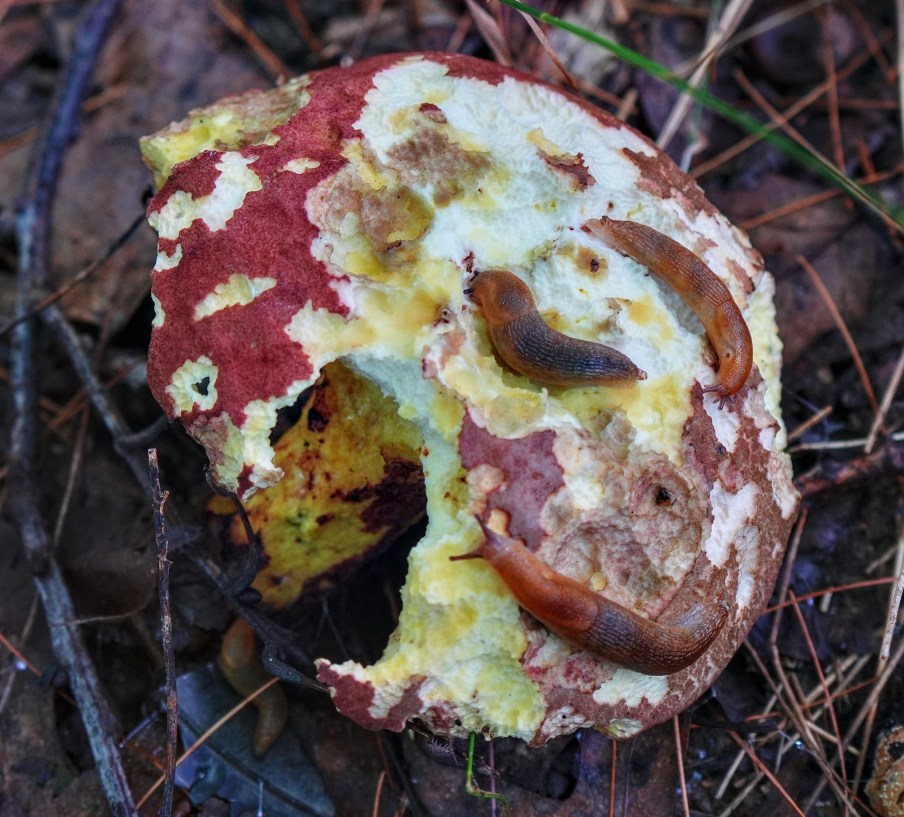Posts in Category: mushroom
Maine! Two fungi and a flower

Three low wide angle perspective shots. Crown-tipped Coral, Golden Fairy Spindle (sometimes Yellow Coral), and a true flower…the Ghost Flower or Indian Pipe, a parasitic plant on some mushrooms, which are themselves parasitic on the tree roots. Sony a5100 with Sony 10-18 f4 zoom at 15mm equivalent. Aperture mode at f10 for depth of field. Processed in Photomator. Assembled in FrameMagic.
Maine! The fruiting forest floor

We have a little patch of woods across the road which I do not pay enough attention too. It was posted for a long time, but it has changed hands and the posted signs are gone, so maybe I will explore it more. This is the time when the forest floor comes alive with mushrooms of all shapes and kinds and I found these in just a short excursion (incursion) in those woods. Clavulinopsis fusiformis, among whose common names I like “golden fairy spindle” best. Some kind of Hygrophore, one of the Lactarus, and a more mature Hygrophore. (Ids courtesy of Siri Knowledge and Google Lens :). Sony a6700 with the Tamron 50-400 Di iii VC VXD zoom at 75-100mm equivalents. Program mode with my macro modifications. f10 for depth of field and all handheld at low shutter speeds due to the lack of light on the forest floor on a cloudy day. Processed in Photomator and assembled in FrameMagic.
Maine! Frost’s Bolete?

Frost’s Bolete? Mushroom, Mousam River Preserve of the Kennebunk Land Trust, Kennebunk, Maine, USA, August 2024 — I would not bet my life on any mushroom ID I make, so this could be something else. They were abundant along the edge of the marsh at the Mousam River Preserve when I visited. I am practicing my near macro skills. 🙂 Sony a6700 with Tamron 50-400 Di iii VC VXD zoom at 75mm equivalent. Program mode with my macro modifications. f10 (for depth of field) @ 1/15th second, hand held. Processed in Photomator.
Maine! Forest perspective

One of the Russula mushrooms I think, from the Mousam River Preserve of the Kennebunk Land Trust. This is one of the other “uses” I had hoped for from the Sony 10-18mm f4 lens when I bought it. It focuses to about 6 inches so these kinds of right down on the forest floor shots are possible. Keeping everything in perspective as we enter mushroom season. Sony a5100 with the aforementioned Sony 10-18mm zoom at 15mm equivalent. Program Aperture @ f10 for depth of field. Processed in Photomator.
Maine! Forest orange

Perhaps Jackson’s Slender Amanita (I love to photograph mushrooms in season but I don’t pretend to know what they are, and I don’t eat them.) Little and bright orange at any rate. Less mature specimens looked like little orange buttons. Sony a6700 with the Tamron 50-400 Di iii VC VXD zoom at 90mm equivalent. Program mode with my macro modifications. Processed in Photomator.
Maine! Tripping Slugs

From my session with the mushrooms of the woods along the Bridle Path…you have to wonder if these slugs are tripping on what looks like Fly Agaric to me. They certainly seem to be enjoying it. Yes I know, yuk. Still I find it to be an interesting photo. Sony a6700 with the Tamron 50-400 Di iii VC VXD zoom at 75mm equivalent. Program mode with my macro modifications. Processed in Photomator.
Maine! Golden Trumpet

Xeromphalina campanella, or Golden Trumpet (aka Fuzzy Foot): Kennebunk, Maine, USA, August 2024 — I found this stump along the Bridle Trail in Kennebunk, absolutely covered with what I think is Golden Trumpet mushrooms. There was a shaft of sun highlighting the little mushrooms and they were attracting quite a few slugs and bugs as well. All three of them shots were taken with the Tamron 50-400 Di iii VC VXD zoom at between 75 and 110mm equivalent. At those focal lengths the lens reaches 1:2 magnification, so near macro and is great for this kind of work. Sony a6700. Program mode with my macro modifications. Processed in Photomator. Assembled in FrameMagic.
Maine! Fly Agaric

One of the Amentia Mascarias or Fly Agarics. They are popping up all over this time of year. This one was along the edge of the Bridle Path in Kennebunk, Maine. There were some full grown ones near by with their flat tops. This is an in-camera focus stack of 8 images. Program mode. OM Systems OMD EM5Mkiii with 12-45mm zoom at 26mm equivalent.
Maine! Focus stacked fungi

One of my excuses for buying the Olympus OMD EM5Miii and the 12-45mm zoom was so that I could do focus stacked macro without taking the 100-400mm zoom off my OM-1. I have a December trip to Costa Rica that features at least 2 macro photography outings. 🙂 And I have not done much real macro while using the Sony RX10iv as it did not lend itself to really close work (and did not have in-camera focus stacking anyway). For those who do not know, focus stacking takes 8-10 exposures, automatically moving focus by a set increment, and then combines those images in the camera to produce an image that has much greater depth of field than a normal exposure…so that macro subjects in particular where depth of field is a real issue, can appear sharp from the very front to the very back. These are a few mushrooms I found along the Bridle Path in Kennebunk last week. I have a little, light weight Sirui carbon fiber tripod that I bought for this purpose exactly, and it works really well. Olympus OMD EM5Miii with the 12-45mm zoom at various focal lengths. Program mode with focus stacking. The only issue is the mosquitoes working this close to the ground for any length of time 🙂
More fascinating fungi from the pond edge

I found all of these mushrooms growing within 20 feet of Day Brook Pond in the sands of the Kennebunk Plains. I continue to be amazed at the numbers and variety of fungi I am finding this season. Top left is probably Laccaria laccata, or the “scurfy deceiver”, then possibly an Amanita, then maybe a Coltricia, and neither I or my AI assistants can come up with a likely name for the last one, but it might be some kind of “fieldcap”. Sony Rx10iv at 600mm equivalent. Program mode with my custom birds and wildlife modifications. Processed in Apple Photos and assembled in FrameMagic.